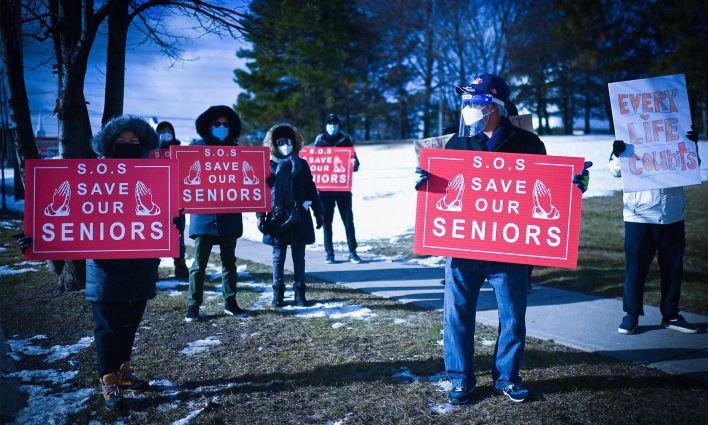In January of 2016, I spent nearly my last 80 bucks, hopped on a Greyhound bus and left for New Hampshire. I was putting aside my career as a rave DJ and writer to start a new job: building the movement to elect Bernie Sanders.
I was about to get an inside look at history in the making, as Bernie’s upstart campaign helped to rekindle the American progressive movement. I didn’t know it at the time, but I was also about to learn, first-hand, a new model of organizing that would empower a scrappy band of rebels and revolutionaries to redefine the political landscape.
Distributed organizing
So what is distributed organizing? If organizing is sharing a vision of a better future and then driving collective action to achieve that vision, then distributed organizing is the same, but using technology, toolkits and trust to empower geographically-dispersed volunteers to take on “rinse-and-repeat” tasks that advance a central goal.
Whew! That’s a mouthful. The simpler version: when volunteers can use technology to quickly plug into a campaign from anywhere and begin meaningfully contributing to the campaign’s goal, you’re doing distributed organizing.
Although likely not the first version of distributed organizing, Bernie 2016 took it to the next level out of necessity. When Bernie began the race, he had hardly any name recognition or national support; in early polls, he often came in at single-digit support. Shocking upsets in the first two contests propelled the campaign into contention. When we won in New Hampshire, Bernie raised a million dollars that night and suddenly our team swelled to include hundreds of thousands of volunteers in all 50 states.
But in the US primaries, states don’t all vote at once. Instead, it unfolds over months, as each week a few more states vote. The challenge then became marshalling all that volunteer energy in a useful way for a long stretch of time across the entire country.
The answer: phone calls.
With distributed organizing, our campaign was able to centrally determine the most strategic groups of people to call, equip volunteers to call into those targets from anywhere in the country, then turn on the firehose and point it where it could do the most good.
When volunteers can use technology to quickly plug into a campaign from anywhere and begin meaningfully contributing to the campaign’s goal, you’re doing distributed organizing.
Distributed organizing in action
After we won New Hampshire, I moved on to Michigan. We were buzzing from the big upset in New Hampshire, but the “first in the nation” primary state is tiny, rural and overwhelmingly white. Michigan is a very different landscape.
I arrived to find an incredible grassroots operation already humming, thanks to local volunteers. It was encouraging, but polls were against us here too — and this time, they showed no signs of budging, despite our efforts on the ground.
When it came time for Michigan to vote, most polls still showed us over 20% behind our opponent. One poll had us down 37 points that week. But alongside an impressive and determined ground game, Bernie’s distributed program had started to fire on all cylinders. On one call I remember hearing one of our field teams telling us that we had nearly 3 million phone calls into the state —in just the final week.
As we wrapped up our final shift on election day, one of our canvassers in the Ann Arbor office where I was stationed asked me “do you think we’re going to win?” Conscious of the polling, but also aware of how strong our canvass operation was, I felt confident replying “I think we’ll do better than the polls.”
Sure enough, we beat the polls. We won by a point and a half. It was one of the biggest upsets in primary history, described by Politico as the “Michigan Miracle.” Distributed organizing unlocked a nationwide army of volunteers that helped put us over the top.
It was one of the biggest upsets in primary history, described by Politico as the “Michigan Miracle.” Distributed organizing unlocked a nationwide army of volunteers that helped put us over the top.
Building a program
But not everyone is a gruff-but-beloved Vermont socialist who’s been on the right side of history for fifty years. So how do you build a distributed organizing program without a national presidential campaign?
To be successful, a distributed organizing campaign must have:
A people-powered theory of change. Volunteers have to believe that their efforts can make a difference. When they do, they’ll work hard to make it happen. People believed Bernie could win and that winning would make a big difference. Becky Bond says of the Bernie campaign: “As it turned out, people were just waiting to be asked to do something big to win something big.”
A support network. Volunteers must know where to get answers, whether that’s a toolkit or a phone call, and oftentimes this is with other volunteers. In the most recent primary, Bernie’s volunteer Slack, email inbox and even his Twitter DMs were all managed by volunteer teams. Supplementing communication from staff organizers with lateral communication between volunteers allows those volunteers to support each other, build each other’s capacity and begin to self-organize — a hallmark of distributed organizing.
Digital infrastructure. The technology connects people at scale. Google Docs allows for a central toolkit, Slack or Discord provide a shared communications space,and Callhub or Thrutalk allow for remote dialing and texting campaigns; whatever your needs, there’s likely an app to solve it. Just don’t forget that the technology is in the service of people, not the other way around. If it doesn’t make things easier for your volunteers, keep looking.
A clear, accessible path for involvement. Volunteers need to be able to plug in quickly, easily and accessibly from a multitude of points of entry.
Volunteer leaders. A successful campaign depends on volunteers taking ownership of the effort and organizing among themselves.
If you’re starting from scratch, you’ll save yourself a lot of stress by putting real thought into your plan before you launch it. Write a comprehensive toolkit. It’s better to be long and thorough than to shorten it but miss things. Have a very clear map of the journey a volunteer goes on when they get involved, all the ways they can join, what roles they can take on and what actions they can take. Know how you’re going to identify leaders and give them essential roles. And set up and thoroughly test your technology before you start rolling—though don’t be afraid to ask volunteers to help with that too!
When you’re ready, kick things off with a launch event. Bernie pioneered a tactic called a “barnstorm” —an organizing meeting where the campaign’s purpose and theory of change is explained, the tactics are laid out and then everyone leaves with a job. For example, we might be running phone banks. After we explain how it all works and why it will help us win change, we’ll ask people to raise their hand (or fill out a Zoom poll) if they’re willing to host a phone bank. Once everyone willing to lead has been identified, we’ll ask everyone else to find their own phone bank host and sign up with them. Just like that, organizing teams have been formed. In 2016, barnstorms were run by staff at first, but the program really took off when the keys got turned over and volunteers started hosting their own barnstorms for each other.
The key principles
After the Bernie campaign ended in 2016, I spent some time on other campaigns in the US before returning to Canada and taking a job with Leadnow, a people-powered progressive advocacy organization. At Leadnow, I’ve had the chance to be a part of many more distributed organizing campaigns, as we fused Bernie-style tactics with Leadnow’s already impressive digital organizing chops.
We’ve coordinated spontaneous rallies against TMX outside over 100 MP’s offices across the country in a matter of days, and poured tens of thousands of calls into key swing ridings during the recent federal election. Most recently, COVID has driven us to push distributed organizing to its limits, and have learned to apply a few key principles every time:
Turn over the keys. As Zack Exley and Becky Bond write in “Rules for Revolutions”, their account of the 2016 campaign, “the revolution will not be staffed”. We hand over as much of the operation to our volunteers as possible, ensuring they help set the agenda and can take ownership of the operation.
Deep, in service of wide. If you’ve heard of the 80/20 rule, it applies. You’ll have some volunteers who want to give 20 or 30 or more hours a week, and you’ll have others who want to pop into an event once every couple of months. By having a core team of highly engaged supporters who can go deep, understand the ins and outs of your systems, and offer support to the more casual volunteers, you can unlock the full extent of their capacity and service a wide range of activities for more casual volunteers.
Live by the toolkit. I cannot stress this enough—every question you answer in the toolkit is a question you won’t get asked 5,000 times (you’ll get asked it 300 times instead, which is at least more manageable). Your toolkit is your volunteer’s one-stop-shop for information about the campaign. Let them know what you’re asking them to do, how they can do it, how they can get help, and how they can find each other, all in a single, centrally managed document. Google Docs is great for this because you can share a single link and if you update the central document, everyone’s toolkit gets updated at the same time. Remember: the strategy is centralized, but the work is distributed.
Eat the burrito. You might think you make a great burrito, but until you try it for yourself, you don’t know what it’s like to eat your burrito. In the same way, it’s great to come up with cool actions for your volunteers to take, but until you’ve taken that action yourself, you don’t know what that experience is like. Try out your phone calls and rallies and technology for yourself early in the campaign so you know what you’re asking your volunteers to do.
Automate it. You are going to experience so many repetitive tasks. Automation exists for exactly that reason, and there are plenty of off-the-shelf automation tools you can find online for cheap. Every step of the process you automate adds up quickly when repeated 5,000 or 50,000 times, and every freed up moment is time your volunteers can spend building real human connection
What Bernie unlocked in 2016 has empowered a transformative wave of grassroots activism and innovation. The technology will continue to advance, new tactics will be tested and deployed; but the underlying principles of empowering volunteers, and using technology to connect people and build relationships at scale, are redefining organizing and will be with us for a long time to come. This is the political revolution in action—and now, everyone can be a part of it.








